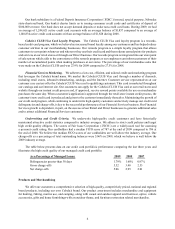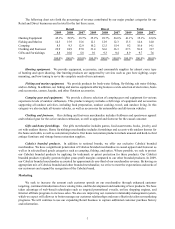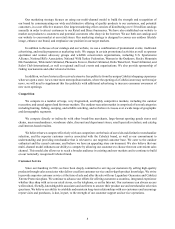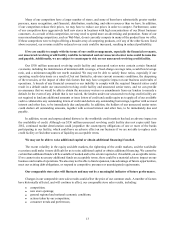Cabela's 2009 Annual Report Download - page 22
Download and view the complete annual report
Please find page 22 of the 2009 Cabela's annual report below. You can navigate through the pages in the report by either clicking on the pages listed below, or by using the keyword search tool below to find specific information within the annual report.13
Many of our competitors have a larger number of stores, and some of them have substantially greater market
presence, name recognition, and financial, distribution, marketing, and other resources than we have. In addition,
if our competitors reduce their prices, we may have to reduce our prices in order to compete. Furthermore, some
of our competitors have aggressively built new stores in locations with high concentrations of our Direct business
customers. As a result of this competition, we may need to spend more on advertising and promotion. Some of our
mass merchandising competitors, such as Wal-Mart, do not currently compete in many of the product lines we offer.
If these competitors were to begin offering a broader array of competing products, or if any of the other factors listed
above occurred, our revenue could be reduced or our costs could be increased, resulting in reduced profitability.
If we are unable to comply with the terms of our credit arrangements, especially the financial covenants,
our unsecured revolving credit facility could be terminated and our unsecured senior notes could become due
and payable. Additionally, we are subject to counterparty risk on our unsecured revolving credit facility.
Our $350 million unsecured revolving credit facility and unsecured senior notes contain certain financial
covenants, including the maintenance of minimum debt coverage, a fixed-charge coverage ratio, a cash flow leverage
ratio, and a minimum tangible net worth standard. We may not be able to satisfy these ratios, especially if our
operating results deteriorate as a result of, but not limited to, adverse current economic conditions, the deepening
of the recession, or the impact of other risk factors that may have a negative impact on our business and results of
operations. A breach of any financial covenant or our inability to comply with the required financial ratios could
result in a default under our unsecured revolving credit facility and unsecured senior notes, and we can provide
no assurance that we would be able to obtain the necessary waivers or amendments from our lenders to remedy a
default. In the event of any default that is not waived, the lenders under our unsecured revolving credit facility are
not required to lend any additional amounts or issue letters of credit and could require us to apply all of our available
cash to collateralize any outstanding letters of credit and declare any outstanding borrowings, together with accrued
interest and other fees, to be immediately due and payable. In addition, the holders of our unsecured senior notes
could declare all outstanding amounts, together with accrued interest and other fees, to be immediately due and
payable.
In addition, recent and unprecedented distress in the worldwide credit markets has had an adverse impact on
the availability of credit. Although our $350 million unsecured revolving credit facility does not expire until June
2012, continued market deterioration could jeopardize the counterparty obligations of one or more of the banks
participating in our facility, which could have an adverse effect on our business if we are not able to replace such
credit facility or find other sources of liquidity on acceptable terms.
We may not be able to raise additional capital or obtain additional financing if needed.
The recent volatility in the equity and debt markets, the tightening of the credit markets, and the worldwide
recession could make it more difficult for us to raise additional capital or obtain additional financing. We cannot be
certain that additional funds will be available if needed and to the extent required or, if available, on acceptable terms.
If we cannot raise necessary additional funds on acceptable terms, there could be a material adverse impact on our
business and results of operations. We also may not be able to fund expansion, take advantage of future opportunities,
meet our existing debt obligations, or respond to competitive pressures or unanticipated requirements.
Our comparable store sales will fluctuate and may not be a meaningful indicator of future performance.
Changes in our comparable store sales results could affect the price of our common stock. A number of factors
have historically affected, and will continue to affect, our comparable store sales results, including:
• competition;
• new store openings;
• general regional and national economic conditions;
• actions taken by our competitors;
• consumer trends and preferences;
























